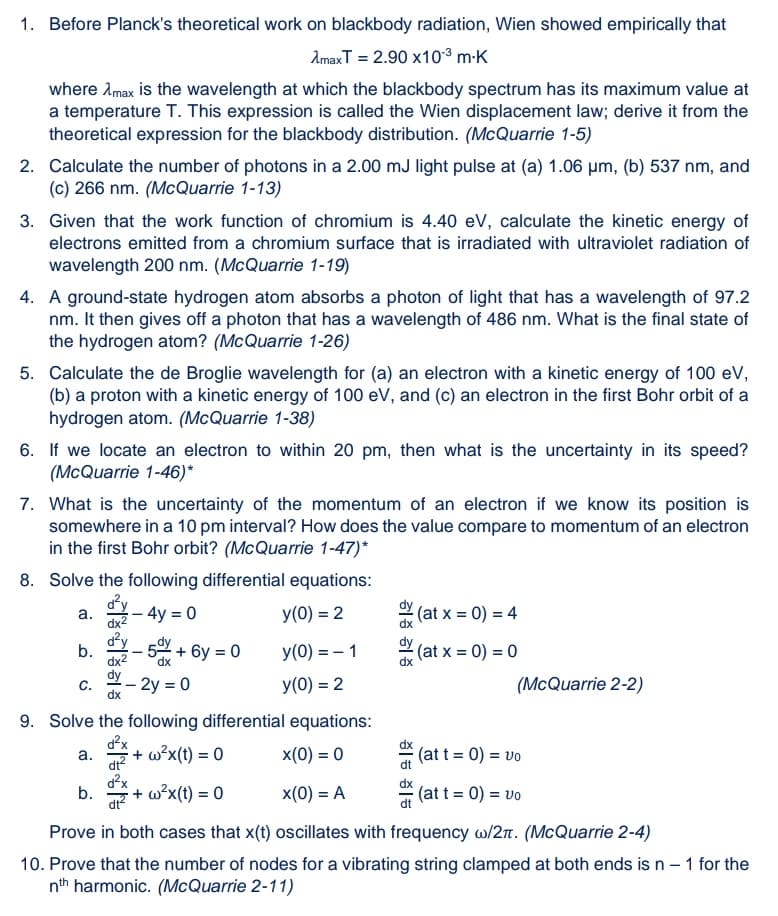Ive the following differential equations: а. dx2 - 4y = 0 y(0) = 2 (at x = 0) = 4 b. dx2 5 + 6y = 0 y(0) = – 1 (at x = 0) = 0 dx dx dy 2y = 0 0) = ? (McQuarrie 2-2)
Ive the following differential equations: а. dx2 - 4y = 0 y(0) = 2 (at x = 0) = 4 b. dx2 5 + 6y = 0 y(0) = – 1 (at x = 0) = 0 dx dx dy 2y = 0 0) = ? (McQuarrie 2-2)
Principles of Modern Chemistry
8th Edition
ISBN:9781305079113
Author:David W. Oxtoby, H. Pat Gillis, Laurie J. Butler
Publisher:David W. Oxtoby, H. Pat Gillis, Laurie J. Butler
Chapter4: Introduction To Quantum Mechanics
Section: Chapter Questions
Problem 9P: The maximum in the blackbody radiation intensity curve moves to shorter wavelength as temperature...
Related questions
Question
Pls answer number 5 thank you

Transcribed Image Text:1. Before Planck's theoretical work on blackbody radiation, Wien showed empirically that
AmaxT = 2.90 x10³ m-K
where Amax is the wavelength at which the blackbody spectrum has its maximum value at
a temperature T. This expression is called the Wien displacement law; derive it from the
theoretical expression for the blackbody distribution. (McQuarrie 1-5)
2. Calculate the number of photons in a 2.00 mJ light pulse at (a) 1.06 µm, (b) 537 nm, and
(c) 266 nm. (McQuarrie 1-13)
3. Given that the work function of chromium is 4.40 eV, calculate the kinetic energy of
electrons emitted from a chromium surface that is irradiated with ultraviolet radiation of
wavelength 200 nm. (McQuarrie 1-19)
4. A ground-state hydrogen atom absorbs a photon of light that has a wavelength of 97.2
nm. It then gives off a photon that has a wavelength of 486 nm. What is the final state of
the hydrogen atom? (McQuarrie 1-26)
5. Calculate the de Broglie wavelength for (a) an electron with a kinetic energy of 100 eV,
(b) a proton with a kinetic energy of 100 eV, and (c) an electron in the first Bohr orbit of a
hydrogen atom. (McQuarrie 1-38)
6. If we locate an electron to within 20 pm, then what is the uncertainty in its speed?
(McQuarrie 1-46)*
7. What is the uncertainty of the momentum of an electron if we know its position is
somewhere in a 10 pm interval? How does the value compare to momentum of an electron
in the first Bohr orbit? (McQuarrie 1-47)*
8. Solve the following differential equations:
Y- 4y = 0
y(0) = 2
(at x = 0) = 4
а.
dx2
d²y
b.
dx2
+ 6y = 0
y(0) = – 1
(at x = 0) = 0
- 2y = 0
У(0) %3D 2
(McQuarrie 2-2)
C.
dx
9. Solve the following differential equations:
+ w?x(t) = 0
x(0) = 0
(at t = 0) = vo
a.
dt?
d?x
b.
+ w°x(t) = 0
x(0) = A
(at t = 0) = vo
Prove in both cases that x(t) oscillates with frequency w/2n. (McQuarrie 2-4)
10. Prove that the number of nodes for a vibrating string clamped at both ends is n - 1 for the
nth harmonic. (McQuarrie 2-11)
Expert Solution
This question has been solved!
Explore an expertly crafted, step-by-step solution for a thorough understanding of key concepts.
Step by step
Solved in 4 steps with 2 images

Knowledge Booster
Learn more about
Need a deep-dive on the concept behind this application? Look no further. Learn more about this topic, chemistry and related others by exploring similar questions and additional content below.Recommended textbooks for you

Principles of Modern Chemistry
Chemistry
ISBN:
9781305079113
Author:
David W. Oxtoby, H. Pat Gillis, Laurie J. Butler
Publisher:
Cengage Learning

Chemistry: The Molecular Science
Chemistry
ISBN:
9781285199047
Author:
John W. Moore, Conrad L. Stanitski
Publisher:
Cengage Learning

Principles of Instrumental Analysis
Chemistry
ISBN:
9781305577213
Author:
Douglas A. Skoog, F. James Holler, Stanley R. Crouch
Publisher:
Cengage Learning

Principles of Modern Chemistry
Chemistry
ISBN:
9781305079113
Author:
David W. Oxtoby, H. Pat Gillis, Laurie J. Butler
Publisher:
Cengage Learning

Chemistry: The Molecular Science
Chemistry
ISBN:
9781285199047
Author:
John W. Moore, Conrad L. Stanitski
Publisher:
Cengage Learning

Principles of Instrumental Analysis
Chemistry
ISBN:
9781305577213
Author:
Douglas A. Skoog, F. James Holler, Stanley R. Crouch
Publisher:
Cengage Learning

Chemistry & Chemical Reactivity
Chemistry
ISBN:
9781133949640
Author:
John C. Kotz, Paul M. Treichel, John Townsend, David Treichel
Publisher:
Cengage Learning

Chemistry & Chemical Reactivity
Chemistry
ISBN:
9781337399074
Author:
John C. Kotz, Paul M. Treichel, John Townsend, David Treichel
Publisher:
Cengage Learning
